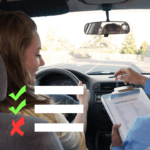Before diving into the topic at hand, it is crucial to talk about the myths surrounding defensive driving. There is a misconception that defensive driving is all about driving with an overly cautious at the lower speed possible. In other words, being “passive” while driving. Nothing farther from the truth.
Read on, what defensive driving really is, and why it is in your best interest to pursue best practices of defensive driving to safeguard you and your family:

What Is Defensive Driving?
Instead of defining right away what defensive driving is, let’s clarify first what it isn’t.
- Defensive driving has nothing to do with chases at high speed.
- Neither has something to do with becoming a “fearful” and thus passive driver.
- Finally, you don’t become a defensive driver just by learning by memory every single law, traffic signal, and road rule.
Although knowing the theory is essential, defensive driving is more a hands-on skillset that improves over time through gaining experience applying its principles. What is defensive driving then?
Defensive driving is a skill set that allows using your senses at their full extent (especially the common sense) to ensuring your safety at all times regardless of road and weather conditions, and even despite the actions performed by other drivers.
Let’s dissect the concept of defensive driving to understand what elements encompass it and how adopting its principles, and best practices can help you taking the best driving choices to reduce collisions.
1. Plan ahead for the unexpected
The first lesson you will receive in any defensive driving course is learning how to scan your surroundings at all times and plan ahead what to do in case of an eventuality. What this means is that you need to train your vision, including your peripherical vision.
By scanning what we mean is literally imagining that you have an Augmented Reality Glasses on and you are constantly analyzing and processing what is happening around you. It’s better illustrating it with an example.
Let’s say you are driving in the countryside and exercising your new skill of “scanning” everything around you. You are making your best to detail what’s going on at both sides, in front of you, at a distance, and also behind you by using the rear mirror. Then you notice that not too far ahead there is a cow, just at the border of the road. The idea here is training your mind for planning for the unexpected. What if the cow decides to cross the road just when I am passing? How would I react in a situation like that? Defensive driving best practices dictate that you should:
- Focus the attention on the possible danger (the cow), but without stopping the surroundings “scanning” process.
- Control the speed and be prepared to have your foot right over the brake pedal before you reach the cow.
- If you have other cars behind you, then activate the hazard lights to alert others about the situation.
- As you come close to the danger check if you can get out the road safely in case of need.
- Once you are upon the threat decrease your speed and concentrate on its actions.
What you gained from following a defensive driving approach? The consciousness of a possible threat and the necessary time to prepare for it. Maybe just a few seconds, but a collision can be decided on that, seconds.
A normal driver may see the cow but because his or her mind is not trained he may continue until the danger is too close. Small details like having your foot on the brake pedal beforehand save you precious time. Your brain may need one or two seconds to react under normal conditions, and then you may need another fraction of second to move your foot. Depending on your speed that can end up in an accident.
At this point, you may think that there is nothing new on the example above because you always proceed as described. If so, what that means is that your common sense is well developed. And as you will find out, defensive driving has a lot to do with common sense.
You can now watch this defensive driving video:
2. Be always alert and distraction-free
As you may guess, in order to scan your surroundings efficiently, you need concentration. So for instance, if you are talking with passengers about a passionate topic, or worse yet arguing, then your mind won’t be able to scan what is happening around the vehicle. Does that mean you can’t talk or hear music while driving? Absolutely not. What that means is that you need training your mind in a way that you can concentrate on your surrounding first, no matter what. Avoiding unnecessary distractions like the cell phone while driving is obvious right? Remember, defensive driving is about common sense.
3. Maintain a safe following distance
This may sound (again) like obvious but for many motorists is not. Defensive driving best practices dictate that you should maintain a safe distance from the vehicle ahead of you. That distance is not static as many think is dynamic. If you are in an urban area, you are probably driving at low speeds, and you only need following the “one car between us” distance rule. But if you are driving on the highway, you can’t maintain such a short distance. A good rule of thumb is using the “two-second rule”. According to that rule, you should stay at least two seconds behind the car directly in front of you.
By the way, the two seconds rule also applies to the car behind you. If you notice that the driver behind you insists on being too close to your car, then your best strategy is letting it pass you. Use your mind not your pride.
4. Always remain calm
Talking about the right mindset, a good motorist knows that letting the emotions led your driving is dangerous. Defensive driving is about being rational, not emotional. Following your instincts is advisable, but that’s completely different from losing your mind while driving. In order to use all your senses, you need to be calm and concentrated. Forgive others mistakes while driving, focus on your goal, safely reaching your destiny.
5. Be prepared to react to anything
If you need to remember something about defensive driving is to be always prepared. Remember our example? If you are driving in the city always keep an eye on children, cyclists, and loaded trucks, everything. Being prepared to anything means not being caught off guard.
6. Control your speed at all times
It’s a fact that the faster you drive, the harder will be to react on time. Defensive driving is not about driving slowly, but neither is about driving as if you were in a race. Respect the speed limits all the time and enjoy the ride.
Constantly Adapt To Road and/or Weather Conditions.
This point is closely related to one of the most important defensive driving principles: using common sense. If you are driving and suddenly start raining or snowing then increase the following distance, reduce the speed, and double your attention to what’s happening around you.
7. Drive predictably for others
Use turning signals, not only because the law says you should, but to alert others about your intentions. Avoid changing your lane without reason. Every time you need to change lines do it slowly, let others knowing what you pretend to do. Avoid surprises for other motorists.
8. Keep your vehicle in good condition
You may ask how this is related to defensive driving. The answer is straightforward. Having your car in good condition makes your life easier, and reduce variables while you drive. The goal is reaching the destination in a safe manner, right? Then check for any mechanical problem, check the tires pressure, headlights condition, etc.
9. Allow enough time for reaching your destination
If you know that you have an important appointment at 12:00 and you estimate it would take you 1 hour to get there then try to be on your vehicle by 10:30. It’s better to spend 30 minutes reading a book or playing with your phone than the stress associated with the unforeseen. What if a collision stops the traffic? What if your tank is empty and the gas station is closed? What if … That’s precisely the problem with unforeseen, you can’t control those situations. If you drive with the pressure of losing your appointment, you can lose focus and thus the probability of an accident increases.
10. Be well rest before taking the wheel
Not only your vehicle need to be in good condition so do you. It’s a fact that driving under the effects of alcohol, drugs, medication, fever, or simply drive sleepy is dangerous. Defensive driving best practices dictate that you should sleep at least 8 hours before taking the wheel. If you are planning a long trip by car, then consider sharing the responsibility with another driver.
11. Never assume other drivers reactions
Always look at what other drivers do. If you notice someone driving suspiciously like doing zig-zag or following an ambiguous path then double your following distance. If you notice someone in a hurry, changing lines and driving recklessly, then let him pass. Never put yourself in a risky condition.
Now that you know a little more about what defensive driving is, try to keep in mind what’s your objective each time you are behind the wheel:
- Use your common sense. Avoid risks.
- Use your head not your emotions.
- Concentrate on what’s happening around you. Scan your surroundings identifying possible threats.
- Always remember your goal: reach your destination in a safe manner.



